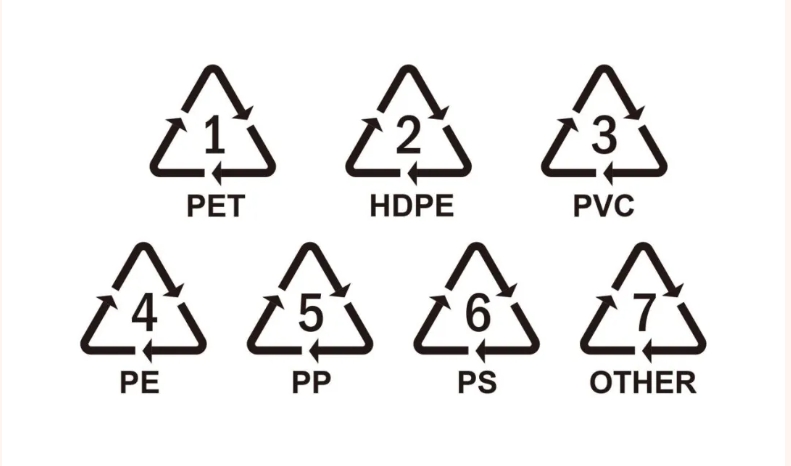
Knowledge about plastic tableware materials
Disposable tableware belongs to food related products and refers to disposable utensils intended for dining or similar purposes, including disposable food boxes, plates, plates, knives, forks, spoons, chopsticks, bowls, cups, cans, pots, etc. Plastic disposable tableware is a disposable tableware made by processing resin or other thermoplastic materials through thermoplastic molding. There are many materials used for disposable plastic tableware, including polypropylene (PP), polyethylene (PE), polyethylene terephthalate (PET), polystyrene (PS), etc.

Each type of plastic product has a triangular symbol with an arrow at the bottom, which is the “recycling” symbol. There are Arabic numerals 1-7 inside, representing the different properties and uses of this plastic material, just like the identification of plastic product materials.
The number “1” represents that the material of the plastic is PET, which is polyethylene terephthalate, commonly used in mineral water bottles, carbonated beverage bottles, etc. It is heat-resistant to 70 ℃, easy to deform, and has harmful substances dissolved from the human body; After 10 months of use, carcinogen DEHP may be released; Cannot be placed in the car to be exposed to the sun, and cannot contain substances such as alcohol and oil. The bottle with this label cannot be filled with water again after use. Please dispose of it in a recyclable bin and let it be recycled.
The number “2” represents that the material of the plastic is HDPE, which is commonly used as packaging bottles for cleaning products and shower products, and is not used for food packaging.
The number “3” indicates that the material of the plastic is PVC. This material is prone to the production of harmful substances at high temperatures, even during the manufacturing process. Toxic substances can enter the human body with food and may cause diseases such as breast cancer and congenital defects in newborns. Containers made of this material are rarely used for packaging food. If in use, do not let it get heated. The cling film made of polyvinyl chloride has good transparency, is not easy to break, strong adhesion, and low price. The film that sticks very firmly on the boxes we see in supermarkets and supermarkets is it. According to its characteristics, it is only suitable for the refrigeration and preservation of vegetables and fruits, and is not suitable for foods containing high fat such as meat and cakes, nor is it suitable for microwave heating.
The number “4” indicates that the material of the plastic is LDPE. Generally, products are made of cling film, plastic film, etc., which have good water barrier properties. Therefore, paper packaging boxes such as milk boxes and beverage boxes use it as the inner film. The heat resistance is not strong. Generally, qualified PE cling film will undergo hot melting when exposed to temperatures exceeding 110 ℃, leaving behind some plastic preparations that cannot be decomposed by the human body. Moreover, wrapping food in cling film and heating it can easily dissolve harmful substances from the oil in the food. Therefore, before putting food into the microwave, the wrapped plastic wrap must be removed.
The number “5” indicates that the material of the plastic is PP. High temperature resistant, commonly found in microwave lunch boxes. Can be reused after careful cleaning. Special attention should be paid to some microwave lunch boxes. The box body is indeed made of No. 5 PP, but the box cover is made of No. 1 PE. As PE cannot withstand high temperatures, it cannot be placed together with the box body in the microwave. For safety reasons, remove the lid of the container before placing it in the microwave.
The number “6” indicates that the material of the plastic is PS. Commonly seen in bowl filled instant noodle boxes and fast food boxes. It is both heat-resistant and cold resistant, but should not be placed in a microwave to prevent the release of chemicals due to high temperatures. And it cannot be used to contain strong acids (such as orange juice) or alkaline substances, as it can decompose polystyrene, which is harmful to the human body and can easily cause cancer. Therefore, you should try to avoid using fast food boxes to pack hot food.
The number “7” represents polycarbonate (PC), which is synthesized from bisphenol A and diphenyl carbonate as raw materials. It has excellent impact toughness and mechanical strength, and good transparency, so it is known as a “transparent metal”. Commonly used to make kettles, cups, bottles, etc., can be reused, but cannot be heated in a microwave. The raw material bisphenol A should be completely a plastic structural component and should not be released during use, but it is often not possible to do so. There may be a small portion of bisphenol A that has not been fully converted into plastic and may be released into food when exposed to heat. Bisphenol A is an endocrine disruptor that is particularly harmful to developing fetuses and children, and may cause miscarriage, congenital intellectual disabilities, and intellectual disability in infants and young children. Therefore, extra caution should be taken during use, including bottles made of polycarbonate, to avoid harm to the sexual development of infants.







